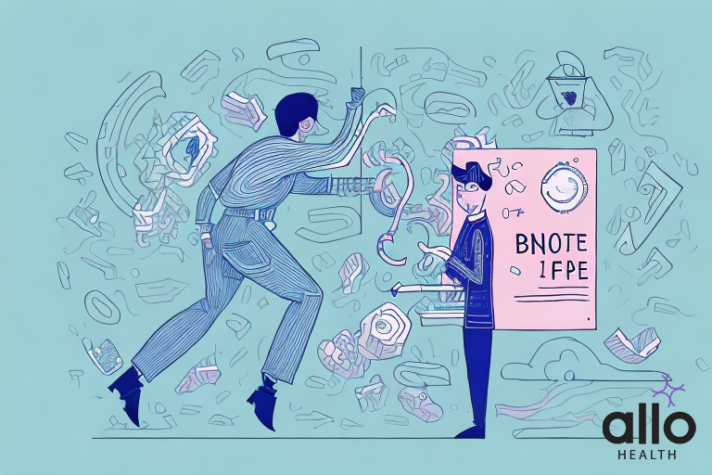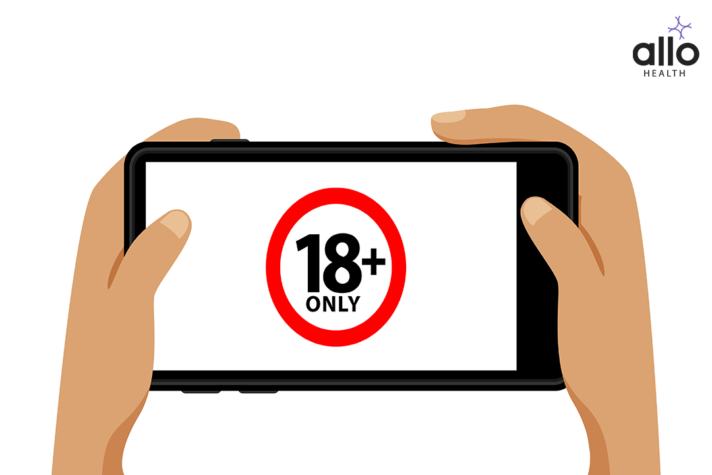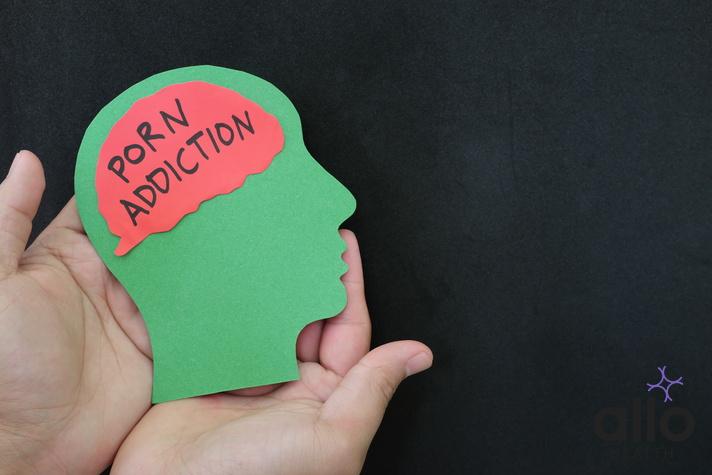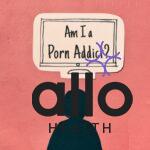Quitting Porn Addiction Cold Turkey: What You Need to Know

Allo Health is dedicated to personalized well-being, offering support and trusted information tailored to individual health goals. The platform emphasizes human-generated content, led by a distinguished medical team of experts, including physicians and sexual health specialists. Their commitment to credibility involves rigorous fact-checking, authoritative research, and continuous updates to ensure accurate, up-to-date information. Allo Health's unique approach goes beyond conventional platforms, providing expert-led insights and a continuous commitment to excellence, with user feedback playing a crucial role in shaping the platform's authoritative voice.

Dr.Sushma.V completed MBBS degree from BGS GIMS,bangalore
Why This Was Upated?
Our experts continually monitor the health and wellness space, and we update our articles when new information became available.
Updated on 04 March, 2024
- Article was updated as part of our commitment to diversity, equity, and inclusion.

"The following blog article provides general information and insights on various topics. However, it is important to note that the information presented is not intended as professional advice in any specific field or area. The content of this blog is for general educational and informational purposes only.
Book consultation
The content should not be interpreted as endorsement, recommendation, or guarantee of any product, service, or information mentioned. Readers are solely responsible for the decisions and actions they take based on the information provided in this blog. It is essential to exercise individual judgment, critical thinking, and personal responsibility when applying or implementing any information or suggestions discussed in the blog."
Quitting porn addiction is no easy feat. It’s a challenging journey filled with hurdles and obstacles that will test your willpower and determination. This is especially true if you decide to go cold turkey – it’s a drastic approach, but sometimes it’s necessary to make a clean break. If you’re considering quitting porn addiction cold turkey, there are a few things you need to know.
What Is Porn Addiction?
Porn addiction, also known as compulsive sexual behavior or problematic pornography use, is a controversial and debated concept within the fields of psychology and mental health. It refers to a pattern of behavior where an individual engages in excessive and compulsive consumption of pornography, leading to negative consequences in various areas of their life. While it is not officially recognized as a mental health disorder in widely accepted diagnostic manuals like the Diagnostic and Statistical Manual of Mental Disorders (DSM-5), some researchers and clinicians acknowledge the existence of problematic patterns of pornography use.
Here are some key aspects often associated with the concept of porn addiction:
- Compulsivity: Individuals with a perceived porn addiction often report a sense of compulsion or an inability to control their use of pornography. This may involve spending excessive amounts of time viewing explicit content, even when the person wants to cut back.
- Negative Consequences: Porn addiction is typically characterized by negative consequences in various life domains, such as relationships, work, and overall well-being. These consequences may include relationship concerns, decreased job performance, or neglect of responsibilities.
- Escalation: Over time, individuals with perceived porn addiction may find that they need to consume more explicit or novel content to achieve the same level of satisfaction. This pattern is similar to the concept of tolerance seen in substance use disorders.
- Distress: Many individuals who believe they have a porn addiction experience significant distress related to their consumption of pornography. This distress may manifest as guilt, shame, or anxiety.
- Interference with Daily Life: When pornography use starts interfering with daily activities, relationships, and responsibilities, it may be an indication of problematic use. This interference can lead to social isolation, relationship conflicts, or difficulties in maintaining employment or academic performance.
It is crucial to note that opinions on the validity of porn addiction as a distinct clinical entity vary within the scientific community. Some argue that the term is stigmatizing and pathologizes normal sexual behavior, while others believe that certain individuals may indeed experience negative consequences related to their pornography use. Additionally, individual attitudes toward pornography can be influenced by cultural, religious and personal beliefs.
If someone is concerned about their relationship with pornography or if it is causing distress or impairment in their life, it is recommended to seek professional help from mental health professionals, such as psychologists or therapists, who can provide a personalized assessment and guidance.
Porn Addiction Causes & Symptoms
The concept of porn addiction is still debated within the scientific community, and it’s important to note that it is not officially recognized as a mental health disorder in widely accepted diagnostic manuals. But, some researchers and clinicians acknowledge that some individuals may experience difficulties related to their consumption of pornography. Causes and symptoms associated with perceived porn addiction can vary, and they are often discussed in the context of compulsive sexual behavior. Here’s an overview:
Potential Causes:
- Biological Factors:
- Brain Chemistry: Some research suggests that exposure to sexually explicit material can activate the brain’s reward system, releasing neurotransmitters such as dopamine. Over time, this may contribute to the development of compulsive patterns of behavior.
- Psychological Factors:
- Escapism: Individuals may turn to pornography as a way to escape from stress, anxiety or other negative emotions. It can serve as a coping mechanism, and in some cases, it may escalate into a compulsive behavior.
- Underlying Mental Health Concerns: Co-occurring mental health conditions, such as depression, anxiety, or trauma, may contribute to the development of problematic pornography use.
- Social and Environmental Factors:
- Access and Availability: The ease of access to explicit content through the internet can contribute to the development of problematic patterns of consumption.
- Cultural and Societal Norms: Cultural attitudes toward sex and sexuality, as well as societal norms, can influence individual behaviors and perceptions of pornography use.
- Relationship Factors:
- Relationship Concerns: Difficulties in intimate relationships, such as communication concerns or sexual dissatisfaction, may contribute to the use of pornography as a substitute or as a way to cope.
Potential Symptoms:
- Compulsivity:
- Loss of Control: Individuals may find it challenging to control the amount of time spent on pornography or to limit the types of content viewed.
- Frequent Engagement: Regular and excessive engagement with explicit material, even in the face of negative consequences or a desire to cut back.
- Negative Consequences:
- Interference with Daily Life: concerns in various life domains, such as work, relationships, or academics, due to excessive pornography consumption.
- Social Isolation: Withdrawing from social activities or neglecting personal relationships in favor of pornography use.
- Psychological Distress:
- Guilt and Shame: Feeling guilt or shame about the behavior, especially if it goes against personal values or cultural/religious beliefs.
- Anxiety or Depression: Symptoms of anxiety or depression may co-occur with problematic pornography use.
- Escalation:
- Increased Tolerance: The need for more explicit or novel content over time to achieve the same level of satisfaction.
- Attempts to Stop or Reduce:
- Unsuccessful Attempts: Individuals may try unsuccessfully to cut back or quit their consumption of pornography.
Approach the concern with sensitivity, recognizing that individual experiences with pornography can vary widely. If someone is concerned about their relationship with pornography or if it is causing distress, seeking professional help from mental health professionals is recommended for a thorough assessment and guidance tailored to the individual’s needs.

Porn Addiction Triggers
Triggers for perceived porn addiction, or problematic pornography use, can be diverse and vary from person to person. Understanding these triggers is important for individuals seeking to manage or address their relationship with pornography. Here are some potential triggers:
- Stress and Anxiety:
- Coping Mechanism: Some individuals may turn to pornography as a way to cope with stress, anxiety, or other negative emotions. It can serve as a temporary escape from daily pressures.
- Boredom:
- Fill in Time: When individuals are bored or have idle time, they may be more prone to engaging in behaviors like watching pornography to pass the time.
- Loneliness and Isolation:
- Seeking Connection: Feelings of loneliness or social isolation may drive individuals to seek a sense of connection or intimacy through pornography.
- Emotional Distress:
- Dealing with Emotions: People experiencing emotional distress, such as sadness, anger, or frustration, may turn to pornography as a way to distract themselves or numb their feelings temporarily.
- Relationship concerns:
- Escaping Relationship concerns: Difficulties in intimate relationships, such as communication concerns or sexual dissatisfaction, may lead individuals to seek satisfaction or escape in pornography.
- Curiosity and Exploration:
- Initial Curiosity: Some individuals may begin using pornography out of curiosity or exploration, and this can develop into a habit over time.
- Accessibility:
- Ease of Access: The easy accessibility of explicit content on the internet can contribute to the development of problematic patterns of consumption.
- Lack of Alternative Coping Mechanisms:
- Limited Coping Skills: If an individual lacks healthy coping mechanisms for dealing with stress or negative emotions, they may be more likely to turn to pornography as a default coping strategy.
- Environmental Triggers:
- Environmental Cues: Specific environments or situations, such as being alone at home, can act as cues or triggers for engaging in pornography use.
- Habitual Patterns:
- Routine and Habit: For some individuals, watching pornography may become a habitual behavior tied to specific times of day or routines, making it difficult to break the pattern.
- Peer Influence:
- Social Pressure: Social or peer influence, including discussions or exposure to explicit material within social circles, may contribute to the initiation or continuation of pornography use.
Triggers are individualized, and what may be a trigger for one person may not be the same for another. Developing self-awareness and understanding personal triggers is a crucial step in addressing and managing perceived porn addiction. Seeking support from mental health professionals can also provide guidance in developing healthier coping strategies and addressing the underlying concerns that may contribute to problematic pornography use.
Porn Addiction Prevention
Preventing perceived porn addiction involves a combination of awareness, education, and the development of healthy habits and coping strategies. While not officially recognized as a mental health disorder, addressing concerns related to problematic pornography use can be important for individuals who feel it negatively impacts their lives. Here are some detailed strategies for preventing perceived porn addiction:
- Education and Awareness:
- Understanding Healthy Sexual Behavior: Promote education on healthy sexual behaviors and relationships. Encourage open and non-judgmental discussions about sexuality, emphasizing that diversity in sexual preferences is normal.
- Communication:
- Open Dialogue: Encourage open communication about sexuality, relationships, and personal values within families, schools and communities. Create a safe space for individuals to discuss their concerns without fear of judgment.
- Media Literacy:
- Critical Thinking: Develop media literacy skills to help individuals critically evaluate and analyze the explicit content they encounter. This includes understanding the potential impact of unrealistic portrayals of sex in media.
- Healthy Relationships:
- Emphasize Healthy Intimacy: Foster an understanding of the importance of healthy, consensual, and respectful relationships. Highlight the emotional and interpersonal aspects of intimacy.
- Develop Coping Skills:
- Teach Healthy Coping Strategies: Educate individuals on healthy ways to cope with stress, anxiety, boredom, and other negative emotions. Encourage the development of a variety of coping skills, such as mindfulness, exercise, or creative activities.
- Establish Boundaries:
- Personal Limits: Help individuals establish and communicate their own boundaries when it comes to media consumption, including explicit content. Encourage the practice of self-control and moderation.
- Parental Controls:
- Use Technology Safeguards: Parents can implement and use parental control tools to limit access to explicit content, especially for younger individuals.
- Promote Offline Activities:
- Diverse Hobbies: Encourage engagement in a variety of offline activities, such as sports, arts, or socializing with friends, to reduce the amount of time spent online.
- Seek Professional Guidance:
- Therapeutic Support: If individuals or families have concerns about pornography use, seeking guidance from mental health professionals can be valuable. Therapists can provide support in developing healthier behaviors and addressing underlying concerns.
- Community Support:
- Support Groups: Community support groups or online forums can offer individuals a sense of community and shared experiences. Connecting with others facing similar challenges can provide encouragement and motivation.
- Regular Check-ins:
- Self-Reflection: Encourage individuals to regularly reflect on their media consumption habits and assess whether it aligns with their values and goals.
- Promote Positive Sexuality:
- Sex-Positive Education: Encourage sex-positive education that emphasizes healthy sexual expression, consent, and communication. This can help reduce the stigma around sexuality.
Approach prevention with a balanced perspective, acknowledging that attitudes toward pornography can vary among individuals and cultures. Prevention efforts should aim to foster a healthy understanding of sexuality, promote communication, and provide individuals with the tools to make informed and positive choices in their lives.
Porn Addiction Treatment
The treatment of perceived porn addiction, or problematic pornography use, involves a comprehensive approach that addresses the underlying factors contributing to the behavior. While not officially recognized as a mental health disorder, individuals seeking help for concerns related to their relationship with pornography can benefit from various therapeutic interventions. Here’s a detailed overview of potential components of porn addiction treatment:
- Assessment and Diagnosis:
- Professional Evaluation: A mental health professional, such as a psychologist or therapist, will conduct a thorough assessment to understand the individual’s history, patterns of behavior, and any underlying factors contributing to perceived porn addiction.
- Psychoeducation:
- Understanding the Behavior: Provide psychoeducation about the nature of problematic pornography use, its potential impact on mental health, and the absence of an official diagnostic category. Help individuals understand the factors that may contribute to their concerns.
- Cognitive-Behavioral Therapy (CBT):
- Identifying and Changing Patterns: CBT can help individuals identify and change maladaptive thought patterns and behaviors associated with problematic pornography use. It focuses on developing coping strategies and addressing distorted beliefs.
- Mindfulness-Based Interventions:
- Mindfulness and Self-Awareness: Mindfulness practices can help individuals become more aware of their thoughts and feelings without judgment. Mindfulness-based interventions may be incorporated to enhance self-awareness and self-regulation.
- Family Therapy:
- Addressing Family Dynamics: If family dynamics contribute to the concern, family therapy can be beneficial. It helps improve communication, understanding, and support within the family system.
- Individual Counseling:
- Exploring Underlying concerns: Individual counseling allows for a personalized exploration of underlying concerns, such as stress, trauma or relationship difficulties, that may contribute to perceived porn addiction.
- Group Therapy:
- Peer Support: Group therapy provides a supportive environment where individuals can share their experiences, receive feedback, and learn from others facing similar challenges. It fosters a sense of community and reduces feelings of isolation.
- Behavioral Interventions:
- Behavioral Strategies: Behavioral interventions focus on modifying specific behaviors associated with perceived porn addiction. This may include setting and achieving behavioral goals, practicing self-control, and implementing positive reinforcement.
- Relapse Prevention:
- Identifying Triggers and Coping Skills: Individuals learn to identify triggers that may lead to problematic behavior and develop coping skills to manage these triggers effectively. Relapse prevention strategies aim to minimize the risk of recurrence.
- Technology Management:
- Digital Well-Being Tools: Implementing technology management strategies, such as setting usage limits, using content filters, or installing parental controls, can help individuals gain control over their online activities.
- Medical Evaluation:
- Rule Out Underlying Medical concerns: In some cases, a medical evaluation may be necessary to rule out any underlying physical health concerns that could be contributing to the behavior.
- Supportive Networks:
- Building Supportive Relationships: Encourage individuals to build or strengthen supportive relationships with friends, family, or support groups. Having a strong support network can be crucial in the recovery process.
It’s essential to tailor the treatment approach to the individual’s specific needs and circumstances. The involvement of a trained mental health professional is crucial to guide the treatment process and provide support throughout the individual’s journey toward healthier behaviors and improved well-being.

Quitting Porn Addiction Cold Turkey: What You Need to Know
Quitting porn addiction “cold turkey” refers to abruptly stopping all engagement with pornography without gradual reduction or weaning. While this approach may work for some individuals, it’s essential to consider various factors and potential challenges. Here’s a detailed overview of what you need to know when attempting to quit porn addiction cold turkey:
- Motivation and Commitment:
- Clear Intentions: Establish a clear understanding of why you want to quit pornography. Motivation and commitment play a crucial role in the success of quitting cold turkey.
- Self-Reflection:
- Identify Triggers: Reflect on the situations, emotions, or circumstances that trigger your desire to consume pornography. Understanding these triggers is essential for developing effective coping strategies.
- Education:
- Understand the Effects: Educate yourself on the potential impact of excessive pornography use on mental health, relationships, and overall well-being. This knowledge can reinforce your commitment to quit.
- Establish Goals:
- Set Realistic Goals: Define realistic and achievable goals related to quitting pornography. This could include specific timeframes, frequency reduction targets, or other measurable objectives.
- Create a Support System:
- Share Your Goal: Inform close friends, family, or a support group about your decision to quit. Having a supportive network can provide encouragement, understanding, and accountability.
- Manage Technology:
- Implement Digital Boundaries: Use technology tools to create boundaries, such as content filters, time restrictions, or parental controls, to limit access to explicit material.
- Distract Yourself:
- Engage in Activities: Find alternative activities to engage in when the urge to consume pornography arises. This can include hobbies, exercise, socializing, or any other positive and fulfilling pursuits.
- Cope with Emotions:
- Develop Coping Strategies: Learn healthy coping strategies for managing stress, boredom, loneliness, or other emotions without resorting to pornography. This may involve practicing mindfulness, deep breathing, or seeking emotional support.
- Delete Content:
- Remove Access: Delete saved explicit content and clear browsing history to reduce easy access. This can minimize the temptation to revert to previous habits.
- Professional Guidance:
- Seek Counseling: Consider consulting with a mental health professional, such as a therapist or psychologist, who can provide guidance, support, and coping strategies tailored to your individual needs.
- Address Underlying concerns:
- Explore Root Causes: Identify and address any underlying concerns contributing to your perceived porn addiction, such as stress, relationship concerns, or unresolved emotional concerns.
- Celebrate Successes:
- Acknowledge Progress: Celebrate small victories and milestones in your journey. Recognizing and rewarding progress can reinforce positive behavior changes.
- Prepare for Challenges:
- Anticipate Setbacks: Understand that quitting cold turkey may come with challenges and occasional setbacks. Be prepared to learn from these experiences and continue moving forward.
- Monitor Mental Health:
- Stay Mindful of Mental Well-Being: Pay attention to your mental health throughout the process. If feelings of distress persist, consider seeking professional help to explore underlying concerns.
Recognize that quitting cold turkey may not be suitable for everyone, and individual experiences can vary. If you find it challenging to quit on your own, seeking professional help can provide additional support and guidance tailored to your specific situation.
Quitting Porn Addiction Cold Turkey Withdrawal Symptoms
Quitting porn addiction, like any form of addiction, can be challenging, and individuals may experience withdrawal symptoms as they attempt to break free from the habit. Withdrawal symptoms can vary from person to person, and the severity may depend on factors such as the level of addiction, personal resilience, and overall mental health. Here are some potential withdrawal symptoms associated with quitting porn addiction:
- Cravings: Intense urges or cravings for pornographic content may be a common withdrawal symptom. It’s essential to recognize these cravings and develop strategies to cope with them.
- Mood swings: Some individuals may experience mood swings, ranging from irritability and frustration to feelings of sadness or anxiety. These mood changes can be a result of the brain adjusting to the absence of the stimuli it has become accustomed to.
- Difficulty concentrating: Porn addiction can affect cognitive function, and withdrawal may initially lead to difficulties with concentration and focus. This can impact daily activities and work.
- Insomnia or changes in sleep patterns: Some people may experience difficulty sleeping or disruptions in their sleep patterns when attempting to quit porn. Sleep disturbances are common during periods of withdrawal from addictive behaviors.
- Physical symptoms: Some individuals may experience physical symptoms such as headaches, increased heart rate, or tension. These symptoms can be stress-related as the body adjusts to the absence of the addictive behavior.
- Anxiety or depression: Porn addiction can contribute to mental health concerns, and withdrawal may initially exacerbate feelings of anxiety or depression. It’s crucial to seek support if these feelings become overwhelming.
- Increased sensitivity to sexual triggers: Initially, individuals may become more sensitive to sexual stimuli in their environment, making it challenging to avoid relapse. This heightened sensitivity may decrease over time with continued abstinence.
These withdrawal symptoms are temporary, and with time, they tend to diminish as the brain adjusts to the absence of the addictive behavior. Seeking support from friends, family, or professionals can be crucial during this process. If the withdrawal symptoms are severe or persistent, it’s advisable to consult with a mental health professional or addiction specialist for personalized guidance and support.
Most Asked Questions
-
What does it mean to quit porn addiction 'cold turkey'?
Quitting porn addiction 'cold turkey' means abruptly stopping all engagement with pornography without a gradual reduction or phased approach. It involves a decisive and immediate cessation of the behavior rather than a gradual tapering off.
-
Is quitting cold turkey an effective approach for everyone?
Quitting cold turkey may work for some individuals, especially those with strong motivation and self-discipline. But, the effectiveness varies from person to person, and it's crucial to consider individual circumstances, triggers, and underlying factors.
-
How can one stay motivated when quitting porn addiction abruptly?
Staying motivated involves setting clear goals, understanding the negative impact of excessive pornography use, and regularly reminding oneself of the reasons for quitting. Establishing a support system, sharing goals with others, and celebrating small successes can also boost motivation.
-
Are there potential challenges associated with quitting cold turkey?
Yes, potential challenges include encountering triggers, facing withdrawal symptoms, and the risk of relapse. It's essential to anticipate setbacks, develop coping strategies, and seek professional guidance if needed to navigate these challenges successfully.
-
What role does technology management play in quitting cold turkey?
Technology management is crucial when quitting cold turkey. Implementing digital boundaries, such as content filters and parental controls, helps restrict access to explicit material. Deleting saved content and clearing browsing history also reduces the likelihood of relapse by minimizing easy access.






































